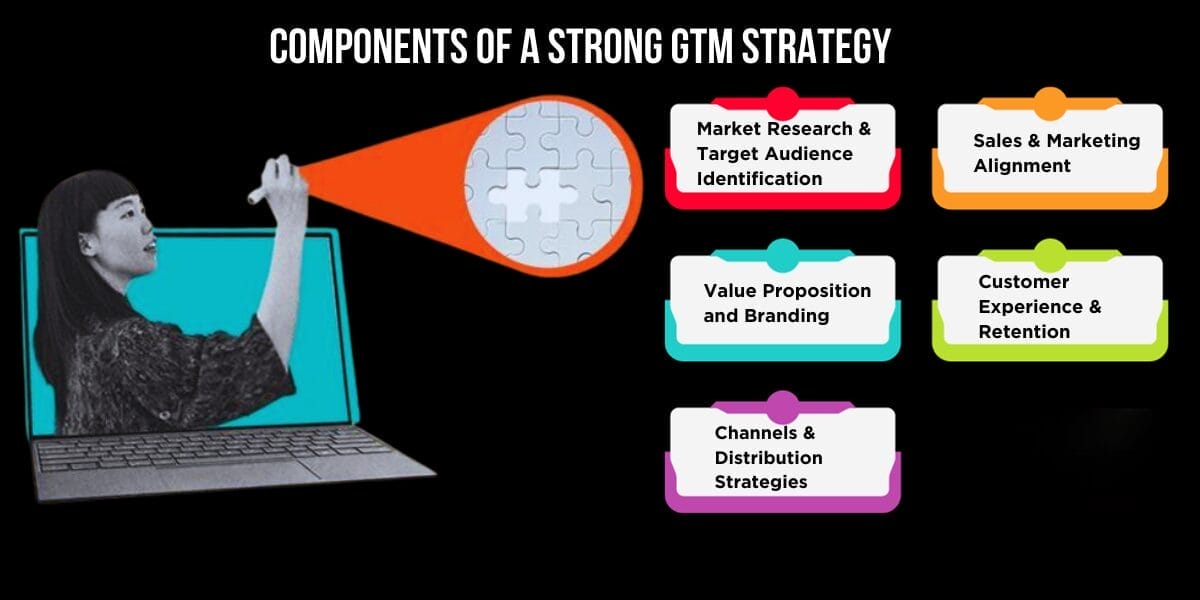Go-to-Market Strategy for Small Businesses to Succeed

In today’s overcrowded marketplace, small businesses often find it challenging to compete with larger, more established companies. However, with a well-defined go-to-market strategy, small businesses can punch above their weight and make a significant mark in their industry. This strategy involves carefully planning and executing a tailored approach to how a product or service is introduced, advertised, and sold to potential customers.
In this article, we will explore the importance of a strong go-to-market strategy for small businesses and how it can level the playing field. We will discuss the key components of a successful strategy, including market research, target audience identification, competitive analysis, and positioning. Additionally, we will delve into various go-to-market tactics, such as pricing, distribution, promotion, and sales channels, that can help small businesses stand out in a crowded marketplace.
By the end of this article, small business owners will have a clear understanding of how to develop and implement a go-to-market strategy that enables them to effectively compete with larger competitors and carve out a niche for themselves in the market.
What is a Go-to-Market (GTM) Strategy


At its core, a Go-to-Market strategy encapsulates the comprehensive plan outlining how a company will reach its target customers and deliver its unique value proposition. It’s the roadmap guiding businesses from product ideation to market penetration, encompassing marketing, sales, distribution, and customer service.
Importance of a GTM Strategy for Small Businesses
Boost Your Business with New AI Trends – Get a Free Strategy Session Today
Understanding the Small Business Landscape


Small businesses encounter numerous challenges, from limited resources and brand recognition to scaling hurdles. Yet, their nimbleness and ability to connect with customers on a personal level provide distinct advantages. GTM strategies serve as a formidable toolset to leverage these strengths and level the playing field.
Challenges faced by small businesses in competing with larger counterparts
Small businesses encounter multifaceted challenges when pitted against their larger counterparts:
- Limited Resources: Scarce financial and human resources often restrict small businesses from expansive marketing and operational capabilities.
- Brand Recognition: Building brand awareness and trust in a market inundated with established brands poses a significant challenge.
-
Economies of Scale: Larger companies benefit from cost advantages due to bulk purchasing, production efficiencies, and widespread distribution networks.
Unique advantages possessed by small businesses


However, within these challenges lie unique advantages that small businesses can leverage:
- Agility and Adaptability: Small businesses can swiftly adapt to market changes, implement innovations, and pivot strategies without bureaucratic hurdles.
- Personalized Customer Experience: Direct customer interactions enable small businesses to offer personalized services, fostering strong customer relationships.
-
Niche Expertise: Specialized knowledge and niche expertise often distinguish small businesses, attracting customers seeking specific solutions.
How GTM strategies can level the playing field


A well-crafted GTM strategy serves as the equalizer for small businesses:
- Targeted Marketing Campaigns: Crafting a GTM strategy that focuses on targeted marketing allows small businesses to reach the right audience without overspending. Utilize data analytics to identify and engage potential customers effectively.
- Strategic Partnerships: Forming strategic alliances with other businesses can provide small enterprises with access to new markets, resources, and expertise. Collaborative efforts can enhance their competitive position.
- Digital Transformation: Embracing digital technologies enables small businesses to streamline operations, enhance efficiency, and reach a broader audience online. An effective online presence is crucial in today’s competitive landscape.
- Customer-Centric Approach: Prioritize a customer-centric approach in your GTM strategy. Leverage your ability to establish personal connections with customers, providing exceptional service that larger competitors may struggle to replicate.
By comprehending these challenges and capitalizing on inherent advantages, small businesses can strategize their GTM initiatives to disrupt markets and challenge industry norms.
In the following sections, we’ll delve deeper into the core components of effective GTM strategies, showcasing how these strategies can be tailored to suit different industries, and providing actionable insights on implementing and evolving these strategies to ensure long-term success.
Components of a Strong GTM Strategy for Small Businesses
In the fiercely competitive business arena, small businesses often find themselves battling against industry giants for market share and consumer attention. However, the ace up their sleeve lies in crafting a strategic Go-to-Market (GTM) approach. This blueprint empowers small businesses to punch above their weight, carving out a distinctive mark in the market. Let’s dissect the components that form the backbone of a robust GTM strategy.


Market Research and Target Audience Identification
Understanding the market landscape is akin to navigating uncharted waters. For small businesses, meticulous market research acts as a compass. It unveils invaluable insights into consumer preferences, emerging trends, and competitor strategies. Identifying the right target audience within this terrain is pivotal. Pinpointing demographics, behaviors, and pain points help tailor products or services with laser precision.
Value Proposition and Branding
The heartbeat of a successful GTM strategy resides in a compelling value proposition coupled with impactful branding. Articulating what sets your business apart is the essence of a strong value proposition. It’s the promise that resonates with your audience and defines your brand’s identity. Crafting a consistent and resonant brand image across all touchpoints reinforces this proposition, fostering trust and recognition.
Channels and Distribution Strategies
Selecting the right channels to reach your audience is akin to choosing the right vehicle for a journey. Small businesses need to assess various distribution channels—be it online platforms, brick-and-mortar stores, or a hybrid model. It’s crucial to align these channels with the preferences and behaviors of your target audience for maximum impact.
Sales and Marketing Alignment
Syncing the efforts of sales and marketing teams is the linchpin of a successful GTM strategy. Both teams must work harmoniously, sharing insights, goals, and strategies. This alignment ensures a seamless customer journey from initial engagement to conversion. Collaborative efforts amplify the impact of campaigns, nurturing leads and driving sales.
Customer Experience and Retention
In a market inundated with choices, a superior customer experience is the catalyst for loyalty. Beyond the sale, nurturing relationships through personalized interactions, exceptional service, and post-purchase follow-ups is imperative. Engaged customers not only return but become brand advocates, amplifying the business’s reach through word-of-mouth.
In amalgamating these components, small businesses forge a GTM strategy that is not only robust but adaptable to the evolving market landscape. It’s a dynamic blueprint, requiring continual assessment, fine-tuning, and innovation.
Remember, the success of a GTM strategy lies not just in its conception but in its execution. Small businesses are the nimble contenders in the market, capable of swift adaptation and innovation. By leveraging these strategic pillars, they not only compete but thrive, leaving an indelible mark in the industry.
Ready to Discuss Your Project? Chat With Our Marketing Team
Implementing the GTM Strategy
In the dynamic landscape of small businesses, mastering the art of Go-to-Market (GTM) strategy is paramount for punching above your weight and leaving a lasting mark. This blog will guide you through the crucial steps to initiate and execute a GTM strategy, emphasize the pivotal role of leadership and team collaboration, and shed light on measuring success through Key Performance Indicators (KPIs).


Steps to initiate and execute a GTM strategy
- Market Analysis: Before diving into your GTM strategy, conduct a comprehensive analysis of your target market. Identify customer needs, competitive landscape, and market trends. This foundational step ensures that your strategy aligns with the current market demands.
- Define Your Value Proposition: Clearly articulate what sets your product or service apart from the competition. Your value proposition should address customer pain points and showcase the unique benefits that your business brings to the table.
- Segment Your Audience: Tailor your GTM strategy to specific customer segments. By understanding the unique needs of different customer groups, you can personalize your approach and maximize the impact of your marketing efforts.
- Choose the Right Channels: Determine the most effective channels to reach your target audience. Whether it’s social media, content marketing, or traditional advertising, align your chosen channels with the preferences and behavior of your customers.
- Develop a Go-to-Market Plan: Create a detailed plan outlining how you will introduce, promote, and sell your product or service. This plan should encompass marketing, sales, and distribution strategies, providing a roadmap for your entire team to follow.
Role of leadership and team collaboration
For a successful product launch and creating a go-to-market strategy, align leadership for resource support and a unified vision. Foster cross-functional collaboration to break down silos, promoting cohesion among departments. Prioritize clear communication of the GTM strategy to help employees understand their roles in launching a new product to market.


Measuring success and Key Performance Indicators (KPIs)
- Establish KPIs: Identify key performance indicators that align with your GTM objectives. Whether it’s customer acquisition cost, conversion rates, or customer satisfaction scores, select KPIs that reflect the success of your strategy.
- Regular Performance Reviews: Schedule regular reviews to assess the performance of your GTM strategy against established KPIs. This iterative process allows you to make data-driven adjustments, ensuring continuous improvement and adaptability in the ever-evolving business landscape.
- Customer Feedback and Adaptation: Actively seek feedback from customers and use it to refine your GTM strategy. Adapting to changing market dynamics and customer preferences is essential for sustaining long-term success.
Overcoming Common Pitfalls
In the whirlwind journey of small businesses aiming to leave a lasting impression in the market, the blueprint of success lies within a well-crafted Go-to-Market (GTM) strategy. However, the path to implementing an effective GTM plan is riddled with challenges that often catch entrepreneurs off guard. Understanding and mitigating these challenges can be the difference between thriving and stumbling in the marketplace.


Identifying and Addressing Implementation Challenges
One of the foremost hurdles in executing a GTM strategy revolves around aligning various internal departments. Discrepancies between sales, marketing, and product teams can impede the seamless execution of the strategy. Additionally, misinterpreting customer needs and market trends can lead to misguided efforts and resource wastage.
Addressing these challenges necessitates a holistic approach. Open lines of communication, cross-departmental collaboration, and regular strategy review meetings become vital. Moreover, realigning strategies based on constant market feedback and data analysis is imperative to stay adaptable.
Strategies for Adapting and Evolving GTM Approaches
Flexibility is key to overcoming challenges in GTM strategies. Being rigid in approach can spell doom for a small business trying to carve its niche. Instead, embrace a culture of iteration. Regularly review and tweak strategies based on real-time feedback, market shifts, and technological advancements.
Investing in technology that enables data-driven decision-making is crucial. Leveraging analytics tools for customer insights, tracking campaign performance, and measuring KPIs can guide strategic pivots effectively.
In essence, the success of a GTM strategy for small businesses hinges on agility, adaptability, and a profound understanding of customer behavior. Embrace failures as stepping stones to success and let them guide your strategy’s evolution.
How Professional digital marketing agency help in creating GTM strategies


In the competitive business landscape, small enterprises face the challenge of standing out. Crafting a winning Go-to-Market (GTM) strategy is essential for survival and success. A professional digital marketing agency is a key ally, helping build a strategy that positions your product uniquely. Whether using a go-to-market plan template or seeking guidance, their expertise ensures success, even without explicitly relying on a go-to-market strategy. Incorporating elements of a winning strategy enhances your chances of thriving in the market, making it essential for new product launches. The agency’s guidance aligns your strategy with market trends, ensuring a successful market entry and lasting success.
In the realm of crafting powerful Go-to-Market (GTM) strategies, Digital Delane emerges as a strategic ally for small businesses aiming to make a substantial impact. Leveraging its specialized expertise and innovative approach, Digital Delane contributes significantly to the creation and execution of effective GTM strategies.
1. Insightful Market Research:
Digital Delane provides comprehensive market insights, delving deep into consumer behaviors and emerging trends. This analysis forms the foundation for tailored GTM strategies, uncovering opportunities for businesses.
2. Precise Audience Targeting:
Utilizing advanced analytics, Digital Delane identifies and profiles the ideal customer base. This precision ensures that GTM strategies resonate effectively with the intended audience.
3. Compelling Content Creation:


The agency excels in creating tailored content that reinforces brand identity and fosters connections. From social media campaigns to informative blogs, their content strategy captivates audiences.
4. Online Presence Strategies:
Digital Delane implements cutting-edge online strategies, including SEO and social media tactics. This amplifies visibility and drives meaningful traffic to digital platforms.
5. Data-Driven Optimization:
Their commitment to data-driven decision-making enables continual refinement of GTM strategies, ensuring adaptability to market dynamics.
6. Clear Metrics and ROI:
Partnering with Digital Delane provides businesses with clear metrics and KPIs, allowing them to track progress and determine the effectiveness of their marketing initiatives.
In essence, Digital Delane’s collaborative approach and expertise elevate GTM strategies, enabling small businesses to establish a strong market presence and foster growth.
Do you want to grow faster? Schedule a free consultation call with an expert
The Future of GTM Strategies for Small Businesses
Looking ahead, the future of GTM strategies for small businesses revolves around seamless digital integration, personalized customer experiences, and adaptive approaches. Embracing advanced technologies like AI, prioritizing omnichannel interactions, and data-driven decision-making will be key. Purpose-driven strategies and a culture of adaptability are crucial for enduring success in an ever-evolving market.


Conclusion
In conclusion, the GTM strategy acts as a crucial tool for small businesses to compete effectively against larger counterparts. Despite challenges like limited resources and brand recognition, a well-designed GTM strategy levels the playing field by leveraging strengths such as agility and personalized customer connections. Collaborating with digital marketing agencies like Digital Delane enhances this strategy, bringing expertise in targeting, content creation, and online optimization.
Looking ahead, the future of GTM strategies for small businesses lies in digital integration, personalized experiences, and adaptability. Embracing technology, prioritizing omnichannel interactions, and data-driven decisions are key. Overall, a refined GTM strategy empowers small businesses not just to survive but to thrive in a dynamic market.








